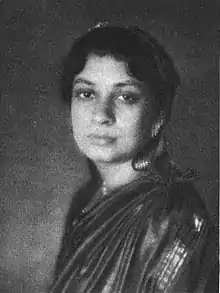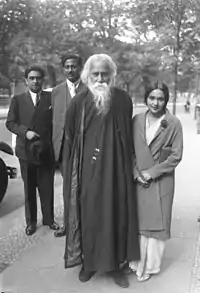Pratima Devi (painter)
Pratima Devi (1893–1969) was an Indian Bengali artist, widely known for her artistic abilities. She was wife of Rathindranath Tagore, son of Rabindranath Tagore. The poet took special interest in developing her capabilities.
Pratima Devi | |
|---|---|
 Pratima Devi, 1921 | |
| Born | 1893 Calcutta |
| Died | 1969 (aged 75–76) Santiniketan |
| Nationality | Indian/Bengali |
| Known for | Traditional Dance, Painting |
| Spouse(s) | Nilanath Mukhopadhyay, Rathindranath Tagore |
Parentage
She was daughter of Seshendra Bhusan Chattopadhyay and Binayani Devi, sister of Gaganendranath Tagore and Abanindranath Tagore.[1][2]
Activities

Pratima studied art under painter Nandalal Bose and Rabindranath Tagore.[1] Rabindranath encouraged her to pursue her artistic talents.[4] She exhibited her work at the Indian Society of Oriental Art, run by the Tagore family, from 1915 onwards.[5] She then moved to Paris, where she studied the Italian "wet fresco" method.[5]
Immediately after her marriage in 1910,Pratima,accompanied by her husband, had lived for sometime at the family estate at Shilaidaha, now in Bangladesh.[6]Subsequently, Pratima returned to Santiniketan and followed in the footsteps of her father-in-law and husband and immersed herself in the activities of Visva Bharati.[2]She also accompanied them in their visits to distant places.[1]She was in charge of the dance curriculum at the music and dance school founded by Rabindranath Tagore in Shantiniketan.[7] She is credited as one of the pivotal influences that shaped Tagore's dance-dramas in the early years.[8]She could easily pick up a new craft and adapt it for the Silpa Sadan curriculum.[1]
Early life, marriage and death
Pratima Devi was born in Calcutta (later Kolkata) on 5 November 1893.[9] She was first married as a child bride to Nilanath Mukhopadhyay, son of Nirode Nath Mukhopadhyay, a classmate of Rabindranath, but after two months Nilanath died suddenly by drowning in the Ganges. Rabindranath Tagore arranged the 17 year old Pratima's marriage to his son, Rathindranath Tagore.[9][10]Rathindranath and Pratima adopted a daughter in 1922 - Nandini, better known by her nickname - Pupee (meaning 'doll' in French).[9][11]Pratima's marriage with Rathindranath seemed to be a happy one in the earlier years, but it started facing rough weather later in life. A somewhat egoistic Rathindranath, who remained an enigma in the 'glittering array of tremendously talented and creative individuals' of the Tagore family, resigned his position as vice chancellor of Visva Bharati University in 1953 and left Santiniketan forever. Pratima remained back in Santiniketan. However, they were in touch with each other through correspondence till Rathindranath's death in 1961.[6][12]Pratima died on 9 January 1969.[2]
Family
Nandini Tagore was married in 1940. Rabindranath composed the song Sumangali bodhu sanchita rekho prane,, for the occasion of his grand daughter's marriage to Giridhari Lala. They used to stay in Chhayanir in Ratanpally.[13][14][6]Nandini's son, Sunandan Lala, attended Patha Bhavana and then went on to complete PhD in synthetic organic chemistry. As of 2012, they stay in Bangalore.[15][16]
Books
Pratima wrote several books. Nirban focussed on the last year of the poet’s life. In Smritichinha, she talks of Abanindranath and Rabindranath. Nritya documents the tradition of dance at Santiniketan. Chitralekha is a collection of her poems and other writings.[2]
References
- "Pratima Devi (1893-1969)". Visva-Bharati. Retrieved 13 March 2016.
- Samsad Bangali Charitabhidhan (Biographical Dictionary), Chief Editor: Subodh Chandra Sengupta, Editor: Anjali Bose, 4th edition 1998, (in Bengali), Vol I, page 185, ISBN 81-85626-65-0, Sishu Sahitya Samsad Pvt. Ltd., 32A Acharya Prafulla Chandra Road, Kolkata.
- Sources of information: Smarak Grantha and When two giants met - Rabindranath Tagore and Albert Einstein
- Tagore, Rabindranath (2011). I Won't Let You Go: Selected Poems Ed: Ketaki Kushari Dyson. Penguin Books India. ISBN 9780143416142.
- Mitter, Partha (2007). The Triumph of Modernism: India's Artists and the Avant-garde, 1922-1947. Reaktion Books. ISBN 9781861893185.
- "কবিপুত্র" [Kabiputra] (in Bengali). Anandabazar Patrika. 18 February 2017. Retrieved 2 August 2019.
- Dutt, Sarkar Munsi, Bishnupriya, Urmimala (2010). Engendering Performance: Indian Women Performers in Search of an Identity. SAGE Publications India. ISBN 9788132106128.
- "Tagore's dance legacy and its relevance". The Hindu. 26 December 2011. ISSN 0971-751X. Retrieved 13 March 2016.
- "Rabindranath's Tagore's Descendants". Archived from the original on 14 March 2016.
- "Rathindranath Part I". Smarak Grantha. Retrieved 5 August 2019.
- "Nandini adopted child of Rathindranath and Pratima". Smarak Grantha. Retrieved 26 July 2019.
- "A Page out of a Radical's Life". The Book Review Literary Trust. Retrieved 26 July 2019.
- "Lyric and background history of the song Sumangali Bodhu Sanchito". All about Rabindra Sangeet. Gitabitan.com. Retrieved 3 August 2019.
- "Rabindranath Tagore at grand daughter's marriage". Pinterest. Retrieved 3 August 2019.
- "Sunandan Lala". Linkedin. Retrieved 26 July 2019.
- "Remembering the genius of Tagore". Deccan Herald, 1 May 2012. Retrieved 26 July 2019.